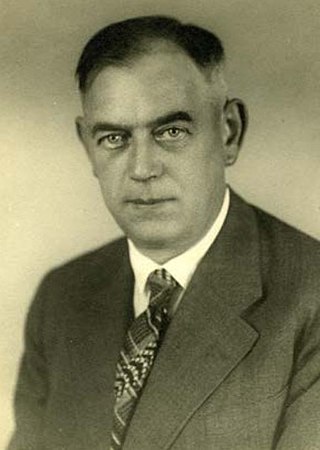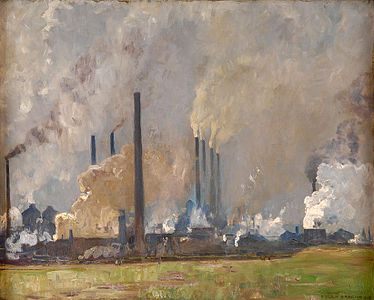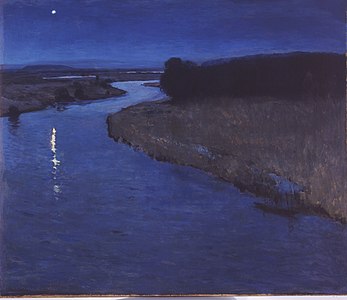Biography
Bracht was born in Morges, Waadt (near Lake Geneva in Switzerland) of German parents. His family later moved to Darmstadt, Germany, where he became a pupil of Karl Ludwig Seeger at the Academy of Fine Arts, Karlsruhe and later studied under Hans Gude in Düsseldorf. Dissatisfied with his work, he moved to Berlin in 1864 and became a merchant, but in 1876 he renewed his interest in painting and joined his former teacher Seeger in Karlsruhe.
A late Romanticist painter, Bracht was known for his moody landscapes and coastal scenes in North Germany, and began a sketching trip through Syria, Palestine and Egypt from 1880 to 1881. In 1882, he became a Professor of Landscape Painting at the Prussian Academy of Arts.
In 1885, he painted the Battle of Chattanooga for the "Philadelphia Panorama Company", a cyclorama which was installed in Philadelphia and Kansas City.
Bracht was supported by Anton von Werner, the conservative director of the Berlin Academy, but cut ties with him during the affair of the closure of Edvard Munch's Berlin exhibition in 1892. [1]
Despite the hostility, when von Werner died, Bracht finished the late painter's panorama of the Battle of Sedan .
Later, Bracht became a representative of German Impressionism.
In 1901, he obtained a teaching position at the Dresden Academy of Fine Arts that he held until 1919. He retired to Darmstadt, where he died in 1921.

Anton Alexander von Werner was a German painter known for his history paintings of notable political and military events in the Kingdom of Prussia.

Karl Christian Ludwig Hofer or Carl Hofer was a German expressionist painter. He was director of the Berlin Academy of Fine Arts.

Hans Fredrik Gude was a Norwegian romanticist painter and is considered along with Johan Christian Dahl to be one of Norway's foremost landscape painters. He has been called a mainstay of Norwegian National Romanticism. He is associated with the Düsseldorf school of painting.

Karl Friedrich Lessing was a German historical and landscape painter, grandnephew of Gotthold Ephraim Lessing and one of the main exponents of the Düsseldorf school of painting.

Eugen Gustav Dücker was a Baltic German painter, in the Romantic style, associated with the Düsseldorfer Malerschule.

Ludwig von Hofmann was a German painter, graphic artist and designer. He worked in a combination of the Art Nouveau and Symbolist styles. His work was part of the painting event in the art competition at the 1928 Summer Olympics.

The Prussian Academy of Arts was a state arts academy first established in Berlin, Brandenburg, in 1694/1696 by prince-elector Frederick III, in personal union Duke Frederick I of Prussia, and later king in Prussia.

Carl Röchling was a German painter and illustrator known for his representation of historical military themes.

Gottlieb Daniel Paul Weber was a German artist. Weber is known for his ethereal and timeless landscape paintings of early northeast America. He emigrated to the U.S. in 1848 and though he returned to Germany around 1860 his influence on American landscape painting was still felt for years.

Karl Gussow was a German painter and university professor.

Rudolf Hellgrewe was a German landscape painter and illustrator. He taught for a long time at the Kunstgewerbemuseum in Berlin. He is the most famous painter of Germany's colonies.

Adolf Friedrich Wilhelm Wachenhusen was a German landscape artist, draftsman and etcher. The focus of his work was on the countryside of his home region, Mecklenburg.

Oskar Frenzel was a German landscape-artist, animal painter and lithographer.

Max Johann Bernhard Koner was a German portraitist.

Friedrich Kallmorgen was a German Impressionist painter who specialized in landscapes and cityscapes.

Adolf Meckel von Hemsbach was a German landscape painter.
Max Schlichting was a painter of German Impressionism. Schlichting, who also worked as a professor and art official, is known for French subjects and depictions of landscapes in Flanders and the Netherlands.

Wilhelm Feldmann was a German landscape painter, etcher, and lithographer.

Wilhelm Reemt ter Hell, known as Willy was a German landscape painter and graphic artist.

Max Wilhelm Roman was a German landscape painter and lithographer.
This page is based on this
Wikipedia article Text is available under the
CC BY-SA 4.0 license; additional terms may apply.
Images, videos and audio are available under their respective licenses.



























